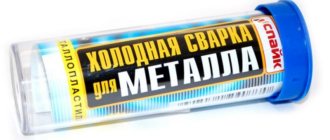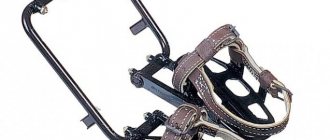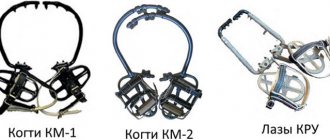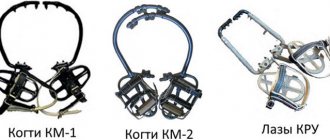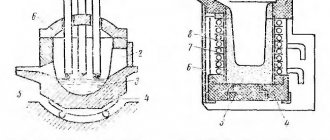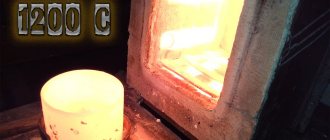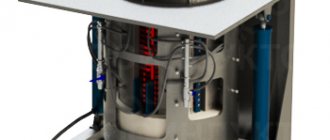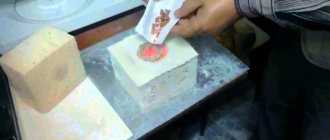Instructions for using a PID thermostat for a muffle furnace
The temperature regulator for a muffle furnace is an integral part of heating equipment, since thanks to it it is possible to maintain the temperature inside at the required level.
When working with an electric muffle furnace, it is very important to maintain the accuracy of the settings. The effectiveness of the impact on materials placed inside for heat treatment depends on this. The PID controller for the furnace is used in all types and varieties of equipment in question. Its main tasks are monitoring the current heating state and automatically controlling the process.
Types of temperature controllers for muffle furnaces
A temperature regulator for a muffle furnace is present in any design. Whether it's an industrial furnace or a device in a research center. Since muffle furnaces differ in size, properties and type of activity, different models of thermostats can be installed on them:
Mechanical oven temperature controller
A mechanical oven temperature controller is a well-known device with a printed scale and a moving mark. It does not allow achieving high accuracy of readings and requires the constant presence of maintenance personnel. Therefore, its use is gradually becoming a thing of the past, and more and more furnace models are equipped with modern control devices.
Sample mechanical thermostat
Automatic Muffle Furnace Controller
The automatic controller of the muffle furnace is controlled using a microprocessor. This approach provides many advantages:
- Possibility of setting the required temperature values.
- Carrying out high-precision heat treatment.
- Simplicity of settings and ease of use.
- There is no need to find a dispatcher-operator.
Digital single task thermostat
PID controller-programmer for muffle furnace
The most popular today is a PID controller-programmer for a muffle furnace. This abbreviation stands for “proportional-integral-derivative” controller.
Its work is based on monitoring the state of a functioning unit and generating the corresponding signal. The analysis is carried out in three stages:
- Proportional . Indicates an immediate response to the current process with the elimination of possible inaccuracies.
- Integral . The deviations that occurred during the entire period of operation are assessed.
- Differential . A forecast is made for the future and to prevent the repetition of mistakes.
Many programmers have two digital displays, which display not only the set temperature, but also the current temperature. It is measured by special sensors that transmit information about both heating and cooling
PID controller for muffle furnace
Oven heater temperature control, with timer on Arduino
We needed an oven to bake polymer clay. After a short search, the choice fell on the KEDR electric oven for the kitchen. Power 600 watts, maximum temperature 250 degrees, no regulator. At first, a thermomechanical regulator was installed, since the temperature required for operation was in the range of 100-130 degrees. But the whole problem was that the furnace had a very large overclocking (after turning off the heater, the temperature continued to rise by another 20-50 degrees), and the regulator had a very large range of switching on and off. That is, setting the temperature to 130 degrees, I received a range of 100 - 160 degrees, which is not acceptable. After several months of analyzing the principles of working with the Arduino IDE and C++, a project was born that fully satisfies the requirements. The device can maintain the set temperature from 100 to 150 degrees, upon reaching which the timer is set for 5-35 minutes, depending on the setting, after which the alarm goes off. Here is a block diagram of how the program works.
The device includes: four series heaters installed in the oven by default, which can be replaced with any other heater of the corresponding power, a solid-state relay SSR-25 DA, Arduino Pro Mini, an incremental encoder with a button connected via an inverting Schmitt trigger, a WH1602D display and two NTCs MF58 thermistors 100 kOhm.
Here is the sketch code, with comments.
Listing #include #include "timer-api.h" const int rs = 12, en = 11, d4 = 5, d5 = 4, d6 = 3, d7 = 6; // connect the LiquidCrystal display here lcd(rs, en, d4, d5, d6, d7); int encCLK = 2 ; // connect the encoder here int encDT = 7; // connect the encoder here int button = 8 ; // connect a button here // in the circuit the encoder is connected through an inverting Schmitt trigger!!! volatile bool button_not_press = true; // store the state of the button here volatile int pinClkValue = 0; // variables for storing the encoder state volatile int pinDtValue = 0; // variables for storing the encoder state uint8_t temp_cel[8] = {B00111,B00101,B00111,B00000,B00000,B00000,B00000}; // degree symbol int temp_upside_pin = 14; // here we connect the first MF58 100k temperature sensor, the calculation is based on it int temp_downside_pin = 15; // here is the second temperature sensor. The second legs are together and on the ground (-), also // two resistor dividers 100k to (+5v). volatile float temp_upside; // temporary values from temperature sensors are stored here volatile float temp_downside; // temporary values from temperature sensors are stored here #define B 3950 // B-coefficient for calculating temperature int heater_pin = 10; // here we connect the solid state relay SSR-25DA. volatile bool preheating_state = false; // preheating state, taking into account the energy of the heated object volatile bool heater_state = true; // heater state volatile int hyst = 40; // taking into account the energy of the heated object, selection by experiment volatile int changeTemp; // state of temperature change over 60 seconds. volatile long timeHyst = 0; // variable for storing time volatile long normalModeTime; // variable for storing time volatile int curTemp = 0; // the current temperature is stored here, after all calculations volatile int setTemp = 0; // the set temperature is stored here int *pCurTemp = &curTemp; // pointers, maybe they are not needed...? int *pSetTemp = &setTemp; // pointers, maybe they are not needed...? volatile bool alarm; // alarm clock volatile int count = 0; // step of changing parameters state*5 volatile int state = 0; // encoder pulse counter volatile int setTimeMinute = 0; // variable to store the timer time in minutes volatile int second = 0; // variable to store the timer time in seconds int *pMinute = &setTimeMinute; // pointers, maybe they are not needed...? volatile long currentTime = millis(); // variable for storing time //========================================================= ============= void setup() { // setting the operating mode of the timer-api.h library, generates an interrupt once per second timer_init_ISR_1Hz(TIMER_DEFAULT); // operating mode of the specified input/output (pin) pinMode(encCLK, INPUT); // CLK encoder input pinMode(encDT, INPUT); // DT encoder input pinMode(button, INPUT); // encoder button input pinMode(temp_upside_pin, INPUT); // midpoint of the voltage divider from temperature sensor 1 pinMode(temp_downside_pin,INPUT); // midpoint of the voltage divider from temperature sensor 2 pinMode(heater_pin, OUTPUT); // relay outputInterrupt(0, clkEnc, CHANGE);// interrupt for encoder control lcd.createChar(1, temp_cel); // create a degree symbol // display a greeting!!! lcd.begin(16, 2); lcd.setCursor(2, 0); lcd.print("Polymer Clay"); lcd.setCursor(0, 1); lcd.print("BURNER ver. 1.01"); delay(2000); // display the menu lcd.clear(); lcd.print("Set"); lcd.setCursor(11, 0); lcd.print("Timer"); lcd.setCursor(0, 1); lcd.print("Cur"); lcd.setCursor(9, 1); lcd.print("NotSet"); setupTemp(); // go to temperature setting mode } //======================================================= ============= void clkEnc(){ // standard encoder interrupt handler, taken from the open spaces pinClkValue = digitalRead(encCLK); pinDtValue = digitalRead(encDT); cli(); if (!pinClkValue && pinDtValue) state = 1; if (!pinClkValue && !pinDtValue) state = -1; if (pinClkValue && state != 0) { if (state == 1 && !pinDtValue || state == -1 && pinDtValue) { count += state*5; state = 0; }} sei(); } //=============================================================== ====== void setupTemp(){ // function for setting the temperature count = 0; // counter reset button_not_press = true; // without this condition, immediately exits the while loop when we enter by pressing the button while(button_not_press){ // until the button is pressed... if (count <= 100) count = 100; // limit the range of temperature changes to at least 100 if (count >= 151) count = 150; // limit the range of temperature changes to a maximum of 150 setTemp = count; // save the temperature value // display lcd.setCursor(4, 0); if(*pSetTemp<10) lcd.print(" "); else if(*pSetTemp<100) lcd.print(" "); lcd.print(*pSetTemp); lcd.print("\1"); lcd.print("C"); lcd.print(" "); if(*pSetTemp !=0)button_not_press = digitalRead(button); // fix the setting preheating_state = true;}} // turn on heating taking into account inertia //=============================== ====================== void setupTimer(){ // setting the timer lcd.setCursor(11, 0); //set the cursor to the desired position lcd.print("Timer"); //display count = 0; // counter reset button_not_press = true; lcd.setCursor(9, 1); //erasing the inscription lcd.print(" "); // NotSet while(button_not_press){ // while the button is not pressed... if (count <= -1) count = 0; // limit the range of time changes in minutes - minimum 0 if (count >= 36) count = 35; // limit the range of time changes in minutes - maximum 35 setTimeMinute = count; // save the time value lcd.setCursor(11, 1); //set the cursor to the desired position if(*pMinute<10)lcd.print("0"); lcd.print(*pMinute); //display MINUTES lcd.print(“:00″); //display SECONDS format 00:00 tempMonitor(); // monitor the temperature if(*pMinute !=0)button_not_press = digitalRead(button);} // fix the setting if (*pMinute != 0){second = 0; timerStart();} // if the timer is set, go to the time counter timeEnd(); } // if time is up, alarm!!! //================================================================ ====== void tempMonitor(){ //This is the whole point of the project!!! // control of heater power by changing the shape and time of the supplied voltage. if(millis() > normalModeTime + 10){ heater_state = !heater_state; normalModeTime = millis();} // measuring and displaying the temperature every half second if(millis() > currentTime + 500){ lcd.setCursor(4, 1); if(*pCurTemp<10) lcd.print(" "); else if(*pCurTemp<100) lcd.print(" "); lcd.print(*pCurTemp); lcd.print("\1"); lcd.print("C"); lcd.print(" "); int US = analogRead(temp_upside_pin); // read the value of sensor 1 int DS = analogRead(temp_downside_pin); // read the value of sensor 2 int MID = (US+DS)/2; // calculate the average value float tr = (5 / 1023.0) * MID ; // convert to voltage float VR = 5 - tr; // calculate the average voltage float RT = tr/(VR / 99000); // calculate the average resistance float ln = log(RT / 100000); float TX = (1 / ((ln / B) + (1 / (25+273.15)))); // simplified Steinhart-Hart equation TX = round(TX - 273.15); // conversion to degrees Celsius and rounding *pCurTemp = int(TX); // save the temperature value currentTime = millis(); } //raise the temperature to the temperature with compensation (set - hyst) if(preheating_state){ if(*pCurTemp < (*pSetTemp - hyst)) digitalWrite(heater_pin, HIGH); //if we have reached the temperature with compensation (set - hyst), //turn it off and wait until the temperature reaches the set value (pSetTemp). else if(*pCurTemp > (*pSetTemp - hyst)) digitalWrite(heater_pin, LOW); if (*pCurTemp >= *pSetTemp){ preheating_state = false; Serial.print(preheating_state); } //if the heating was not sufficient and the temperature began to fall without reaching the desired value //then we turn on the heater again, which will be turned off by the condition of the previous cycle //as a result of which the voltage will be supplied in pulses, which will not result in a rapid //rise in temperature. This process will continue //until the temperature begins to increase again. if (millis() > timeHyst + 30000){ changeTemp = *pCurTemp; //once every 30 seconds, save the temperature for comparison timeHyst = millis(); } if(changeTemp >= *pCurTemp){ if(!digitalRead(heater_pin)){ digitalWrite(heater_pin, HIGH);}}} //if the temperature has reached the specified (pSetTemp) value //go to the temperature maintenance mode including heating with limitation heater power //when the temperature drops below 5 degrees from the set one if(!preheating_state){ if(*pCurTemp < *pSetTemp - 5) { digitalWrite(heater_pin, heater_state);} else digitalWrite(heater_pin, LOW); }} //============================================================== ====== void timer_handle_interrupts(int timer){second—;} //=============================== ===================== //the timer displays the set time and counts down //using the second variable, which is decreased by an interrupt //it turns on after the set time has elapsed alarm. void timerStart(){ while(*pMinute+second != 0){ if (second == 0){(*pMinute)—; second = 59;} lcd.setCursor(11, 1); if(*pMinute<10)lcd.print(" "); lcd.print(*pMinute); lcd.print(":"); if(second<10)lcd.print(“0″); lcd.print(second); lcd.print(" "); if(alarm){ noTone(9); if(!digitalRead(button)){ alarm = false; noTone(9); return;}} tempMonitor(); if(alarm) tone(9,100); }} //============================================================== ===== //Alarm clock!!! void timeEnd(){ alarm = true; lcd.setCursor(11, 0); lcd.print("Alarm"); *pMinute = 1; //second = 30; //the alarm clock runs at the set <- time, if not timerStart(); //turn off, then the set temperature will be reset to 0 if(alarm){ //and the temperature setting mode will start, the heater will be turned off *pSetTemp = 0; //if you press the button while the alarm is running, it will turn on again digitalWrite(heater_pin, LOW); //timer setting mode, supporting the previously set temperature lcd.setCursor(4, 0); if(*pSetTemp<10) lcd.print(" "); else if(*pSetTemp<100) lcd.print(" "); lcd.print(*pSetTemp); lcd.print("\1"); lcd.print("C"); lcd.print(" "); alarm = false; }} //============================================================== ====== //the main loop does almost nothing void loop() { tempMonitor(); // <- start temperature monitoring if(*pSetTemp == 0 && !digitalRead(button)) setupTemp(); // <- if the alarm clock reaches 0 if(*pCurTemp == *pSetTemp) setupTimer(); } // <- if you turn off the alarm clock Since this is one of the first projects, I ask for more criticism!
Tips for installing a thermostat for a muffle furnace
The temperature regulator for a muffle furnace, the instructions for which are simple even for beginners, comes complete with the main equipment. If desired or if necessary, it can always be replaced. This work is not difficult, the whole process takes very little time.
In addition to the instruction manual, on the side of the device you can find a detailed diagram for connecting the terminals, marked by number. The polarity is indicated next to each designation, which must be observed.
Location of the programmer connection diagram
During operation of the device, the current heating temperature of the furnace is highlighted in red, and the specified parameters are highlighted in green. If a difference occurs in the data, the relay is activated, to which the controller signal is supplied.
If the connection is made incorrectly or the user has mixed up the wires, the system will inform about this by displaying negative values
Laboratory furnaces and industrial units cannot do without thermostats. Any production or research activity implies mandatory compliance with the accuracy of the settings. The required controller for a muffle furnace can be purchased at specialized retail outlets or online stores. Contact trusted suppliers, such as the Labor trading house, whose employees will always help you choose the right equipment.
Source
Necessary materials
Directly for the manufacture of the furnace you will need the following materials:
- fireclay brick
- one and a half kW spiral
- heat-resistant clay or mortar
After its manufacture, it is placed in a casing. It can be welded from 2 or 3 mm steel sheets. Its dimensions are taken based on the size of the oven. You can also use an old gas or electric oven as a casing, after first removing all plastic parts and elements from it. The space between the furnace and the casing is filled with insulating material such as mineral wool.
Vertical loading kilns are better suited for ceramic firing. In furnaces where work will mainly be carried out with melting, hardening or other processing of metals, the heating process of the product should be controlled by using a temperature sensor; workpieces are loaded into such chambers horizontally.
Let's look at a step-by-step example of a muffle furnace
In this case, an old iron rectangular tank is used for the casing. It needs a little tweaking and it will be fully suitable for its role. Using a grinder, I cut off the edge of the tank, which has a round hole, 5-10 cm wide. Along the edges we drill holes for fastening the door to the body on the curtains.
The work should begin with planning: Assemble the oven dry from brick, make markings on it from the inside, in those places where the spiral will need to be laid. In the brick, according to the markings made earlier, using a drill, using a Pobedit drill, you should make indentations. In the illustration below, the drill is placed at an angle to the groove, this is how the desired result can be optimally achieved.
We put the prepared brick into the oven; an external frame for it should be made from the corner. We put a spiral into the grooves. We coat the entire structure with a solution of mortar and water. All cracks should be sealed.
Next, you should make an electronic unit that will control the heating of the coil. Moreover, heating the oven will not be easy, but it will be a stepwise heating. For this, a step thermostat is used. A stand should be made for the muffle furnace to avoid losses below. The frame from the corner is cut out and welded at the corners, legs are welded on the sides, also from the corners. A row of plates is welded on top.
We use special fiberglass heat shrink. It serves to protect a thermocouple, the characteristics of which are as follows: chromel-alumel (TCA) diameter 0.5 mm, length 1 m. We also use a ceramic tube with two holes for a thermocouple. You will also need thick heat shrink to power the spiral. We put a heat-resistant fiberglass casing on the thermocouple, and insert its end into a ceramic tube. At the top of the stove, a hole is made with an ordinary drill and a thermocouple must be inserted there and covered with a lethal solution. Let it dry.
To connect, you will need a special heat-resistant wire for electric ovens. The coated stove is hidden in a casing; its thermal insulation will be provided by basalt wool. At the top of the casing body you need to make a hole for the output of power wires and a thermocouple to control it. Before final packaging in cotton wool, a test connection of the oven should be made.
The device itself is installed on an asbestos sheet. The placement of cotton wool should be carried out wearing medical gloves. Control unit for the furnace. Next, we proceed to the manufacture of the furnace control unit.
The set of components consists of:
- housing (taken from a small electrical panel)
- electromagnetic contactor (in this case also “Soviet”)
- terminal blocks (one ceramic one for connecting the nichrome spiral from the muffle furnace to the power wires, and more made of fire-resistant plastic for the main switching)
- 16A automatic; bolts, nuts, engravers; thick wire and plug
- thermostat Profile-M-1K multi-stage single-channel
The thermostat can heat according to a complex schedule; you can set the heating time and temperature during this interval.
A muffle furnace is a design used for melting metals, firing ceramics, hardening steel, etc. Such a furnace is especially valuable for those specialists who work at home. One of the disadvantages of muffle furnaces is their high cost, and therefore a do-it-yourself unit will be very relevant for most home craftsmen.
How to measure the temperature in a muffle furnace
Very often, ceramists who have a homemade muffle furnace wonder how to measure the temperature in this very furnace. There are several proven methods for this.
1. Determination of temperature by the color of the shard
This is the most cost-effective way. But at the same time it is quite complex, because... The temperature must be determined by the color of the hot ceramics in the furnace. With some skill, this can be done quite accurately. An approximate correspondence between color and oven temperature is shown in the figure below.
2. Pyrometric cones (pyroscopes)
A pyrometric cone is a ceramic pyramid that, under the influence of a certain temperature, begins to soften and fall. Each cone has its own number and is designed for its own temperature range (see picture above).
The pyramids are installed on supports made of a material more refractory than the pyrometers themselves, for example, fireclay, to a depth of 3-4 mm.
Usually, several cones of different numbers are placed - one in the middle for the operating temperature, the others for a lower and higher temperature. During firing, the working pyroscope must bend down and reach the bases. In this case, the cone with the number below lies almost completely, and the one with the number above tilts slightly. The condition of the cones is usually monitored during firing through a viewing window and, as soon as the working cone touches the surface, the kiln is turned off.
Necessary materials
Directly for the manufacture of the furnace you will need the following materials:
- fireclay brick
- one and a half kW spiral
- heat-resistant clay or mortar
After its manufacture, it is placed in a casing. It can be welded from 2 or 3 mm steel sheets. Its dimensions are taken based on the size of the oven. You can also use an old gas or electric oven as a casing, after first removing all plastic parts and elements from it. The space between the furnace and the casing is filled with insulating material such as mineral wool.
Vertical loading kilns are better suited for ceramic firing. In furnaces where work will mainly be carried out with melting, hardening or other processing of metals, the heating process of the product should be controlled by using a temperature sensor; workpieces are loaded into such chambers horizontally.
Let's look at a step-by-step example of a muffle furnace
In this case, an old iron rectangular tank is used for the casing. It needs a little tweaking and it will be fully suitable for its role. Using a grinder, I cut off the edge of the tank, which has a round hole, 5-10 cm wide. Along the edges we drill holes for fastening the door to the body on the curtains.
The work should begin with planning: Assemble the oven dry from brick, make markings on it from the inside, in those places where the spiral will need to be laid. In the brick, according to the markings made earlier, using a drill, using a Pobedit drill, you should make indentations. In the illustration below, the drill is placed at an angle to the groove, this is how the desired result can be optimally achieved.
We put the prepared brick into the oven; an external frame for it should be made from the corner. We put a spiral into the grooves. We coat the entire structure with a solution of mortar and water. All cracks should be sealed.
Next, you should make an electronic unit that will control the heating of the coil. Moreover, heating the oven will not be easy, but it will be a stepwise heating. For this, a step thermostat is used. A stand should be made for the muffle furnace to avoid losses below. The frame from the corner is cut out and welded at the corners, legs are welded on the sides, also from the corners. A row of plates is welded on top.
We use special fiberglass heat shrink. It serves to protect a thermocouple, the characteristics of which are as follows: chromel-alumel (TCA) diameter 0.5 mm, length 1 m. We also use a ceramic tube with two holes for a thermocouple. You will also need thick heat shrink to power the spiral. We put a heat-resistant fiberglass casing on the thermocouple, and insert its end into a ceramic tube. At the top of the stove, a hole is made with an ordinary drill and a thermocouple must be inserted there and covered with a lethal solution. Let it dry.
To connect, you will need a special heat-resistant wire for electric ovens. The coated stove is hidden in a casing; its thermal insulation will be provided by basalt wool. At the top of the casing body you need to make a hole for the output of power wires and a thermocouple to control it. Before final packaging in cotton wool, a test connection of the oven should be made.
The device itself is installed on an asbestos sheet. The placement of cotton wool should be carried out wearing medical gloves. Control unit for the furnace. Next, we proceed to the manufacture of the furnace control unit.
The set of components consists of:
- housing (taken from a small electrical panel)
- electromagnetic contactor (in this case also “Soviet”)
- terminal blocks (one ceramic one for connecting the nichrome spiral from the muffle furnace to the power wires, and more made of fire-resistant plastic for the main switching)
- 16A automatic; bolts, nuts, engravers; thick wire and plug
- thermostat Profile-M-1K multi-stage single-channel
The thermostat can heat according to a complex schedule; you can set the heating time and temperature during this interval.
This is what the finished device looks like:
Thermocouple for muffle furnace “PM”
A thermal sensor, or otherwise a thermocouple, is a necessary part of a muffle furnace; it is used to measure temperatures inside the working chamber in the range from 0C to 1250C inclusive, providing high accuracy of readings up to ±0.01C. The thermocouple has increased resistance to the processes of corrosive and oxidative effects of the environment in the working chamber when firing various materials, due to the formation of a protective film on the surface of the sensor during the heating process, which protects the metal from direct contact with oxygen. This gives an increased service life of the temperature sensor, but it still wears out and, like any spare part, fails after many years of operation.
- Elena:
09.24.2017 at 07:10
Thanks a lot. The article is very helpful. Right now we are building our own kiln. True, we use ARIES 251, but the essence is clear. Your articles are very useful, we consider your site as a reference book for dummies. Thank you again for not being greedy and sharing the necessary information.
Answer
- Yuri Gorniy:
09.24.2017 at 12:45
Please) Only when connecting Aries is it easier to use a solid-state relay instead of a triac.
Answer
Elena:
09/30/2017 at 08:17
Yes, we also purchased a solid state relay.
Answer
- Yuri:
07/26/2019 at 11:35
Thank you, kind man!
Answer
- Ivan:
01/12/2021 at 12:18
Need advice on control unit
Answer
How to measure the temperature in a muffle furnace?
Muffle furnaces are heating installations intended for melting metals, firing ceramics and conducting laboratory research. These are the most reliable and affordable furnace installations. They can be used not only for processing products in large volumes, but also in small private companies for processing products in small quantities. Also, muffle furnaces are in demand among those for whom working with ceramics is a favorite activity that brings only pleasure.
Temperature is the main factor in determining which oven is right for you. First of all, you should decide what materials you will work with, whether they require high, medium or low temperature treatments.
Materials that require low firing temperatures include pottery and glass, porcelain tiles can be designed for both medium and high temperature firing kilns, and porcelain requires the highest temperature levels. Additionally, it is important to buy a stove that exceeds the maximum temperature required for your job. Over time, the oven's power decreases, which means its ability to withstand high temperatures also decreases, which is something to consider for the future.
Whoever the owner of a muffle furnace is: a professional with extensive experience or a novice in this business, sooner or later he will have the problem of accurately measuring the temperature in a muffle furnace. Despite the huge range of various measuring instruments, often with its help you can only determine what maximum temperature load a particular processed material can withstand, and not the temperature of the furnace itself. Today we will talk about instruments and methods for measuring temperature in a muffle furnace.
Possible problems when creating a furnace
When manufacturing a device, difficulties arise with the selection of material and installation of a temperature control system.
Incorrectly selected materials lead to rapid destruction of the muffle.
Thus, some craftsmen, to save money, use low-quality bricks and clay-sand mortar instead of fireclay. This leads to cracks in the muffle and heat loss.
The cracked muffle is temporarily sealed with a solution of fireclay clay. The camera needs to be removed and replaced with a new one.
If the furnace is connected to the network without a thermostat, the temperature in the muffle is not controlled. This leads to damage to products that require firing at a given temperature.
To solve the problem, you should purchase a thermostat and electrical equipment, assemble a control unit and connect it to the heating elements of the muffle.
For ease of assembly, it is better to make it with removable front and back covers that are secured with screws. A door is attached to the front cover on a hinge, which should open horizontally. A ceramic element is installed on the door using two bolts through asbestos gaskets, and the gaps are sealed with clay.
The ends of the nichrome wire are brought out to the back cover of the case. Ceramic insulating “beads” must be strung on both terminals. The wire is attached to the pin connector. Such connectors, as well as insulating “beads,” can be taken from old electrical appliances. A standard cord with a plug will be attached to the connector for connection to the electrical network.
All free space between the heating elements and the housing should be tightly filled with asbestos chips. In addition, the design of the furnace must provide a grounding terminal.
For ease of work, two small holes need to be made in the heating chamber: one on the back wall with a diameter of 10 mm - for installing a thermocouple, the other on the door with a diameter of 18-20 m - to observe the interior of the furnace during operation. Both openings must be equipped with closing metal curtains.
A lining plate made of thin stainless steel 0.5–0.8 mm should be placed at the bottom of the working chamber.
The oven is designed for 220 V AC. Heats up to a maximum temperature of 950 degrees within an hour. The weight of the stove is about 10 kg.
Pyrometric cones (pyroscopes)
The pyrometric cone is a small ceramic pyramid. Under the influence of high temperatures, the pyramid changes its physical characteristics: it becomes soft and shapeless. You will have to use several cones that are designed for different temperature loads. Each of the cones has its own number and is destroyed under different thermal influences.
Pyramids are laid out on special substrates that are not as susceptible to melting as ceramics. Basically, the substrates are made of fireclay. The pyramids are installed to a depth of no more than 4 mm.
To obtain the most accurate data, three different types of pyramids are simultaneously placed in the oven. The order of arrangement of the cones is as follows: on one side there is a cone designed for exposure to maximum high temperatures, in the middle - designed for the operating temperature of the muffle furnace, and the third pyramid, designed for low temperatures. The top of the pyramid, for which the set oven temperature turned out to be working, will tilt during the deformation process and reach the surface of the substrate. The pyramid for which the temperature turns out to be critical (this is the one that is designed for a low thermal impact threshold) will melt and completely “lie” on the substrate. The third cone, which can withstand heavy loads, can tilt slightly. You can observe the pyramids through a special viewing window. When the working cone touches the substrate, heating of the furnace is stopped.
Pyrometric cones are the most used elements in determining the temperature of a muffle furnace. But they cannot be classified as high-precision methods for calculating temperature. This method is more suitable for calculating how much heat a particular type of pyroscope can absorb.
The oven is heated to 1010 °C. Pyramid No. 105 does not change its position at all, but when the temperature rises to 1060°C and, having kept the pyramid under such influence, for a short period of time its top begins to melt and “lay down” on the substrate. The temperature characteristics of pyroscopes are close to the thermal properties of ceramics. Because of this, many ceramists use this method.
Thermal insulation of the furnace
As a result of the described actions, an almost ready-made firebox of the hardening furnace is obtained; it only needs to be placed in the housing, securely fastened and heat loss minimized. For this purpose, a pre-made container with legs is useful.
The internal volume of the container must be filled with mineral wool with a density of 45–50 kg/m3. The cotton wool needs to be rolled into a spiral, first placing it under the outer walls and gradually moving towards the center. The packing density should be maximum, but the wool itself should not be damaged. As a result, the firebox assembly needs to be placed in the central fold. If the density of the wool is sufficient, the heating part will not crush the insulation with its weight. All leads of the spirals must be carefully wrapped with fiberglass, spacers made from scraps of mineral wool must be inserted between them, and then brought out through the back wall, connected to the back side of the studs and the panel installed in place.
To securely secure the firebox and install the door, the cotton wool needs to be pressed down and sunk 6–8 cm deeper than the sides. The surface of the insulation needs to be sprinkled with alabaster milk several times so that the cotton wool hardens and stops intensively absorbing moisture. After this, the front part of the furnace is filled with a mixture of alabaster, sand and mineral fiber. While the composition has not hardened, a fire door or mortgages are built into it to secure it.
Temperature rings
PTCR temperature rings are a relatively new method of pyroscope application. They can also be used to determine the amount of heat absorbed by ceramics. This option is more accurate than the previous one. As the temperature increases, the rings decrease in size, and using a micrometer to determine the size of the ring after firing will make it possible to convert the resulting value into a temperature equivalent. The exact correspondence between ring diameters and PTCR STH and LTH temperatures is presented in the table below.
Unfortunately, this method is not practical if you need to calculate temperatures directly during the operation of the muffle furnace. The rings contract in diameter slowly and it is very difficult to understand anything with the naked eye.

